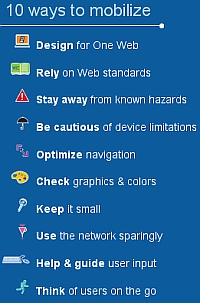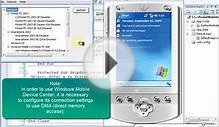
The widespread deployment of Web-enabled mobile devices (such as phones) make them a target of choice for content creators. Understanding their strengths and their limitations, and using technologies that fit these conditions are key to create success mobile-friendly Web content.
What is specific to authoring for mobile devices?
 Mobile Web Best Practices Flip Cards Summarize the Guidelines
Mobile Web Best Practices Flip Cards Summarize the Guidelines
Ideally, site authors would be able to meet the growing demand for a quality mobile experience without changing a line of code. But the reality is that a site designed specifically with mobility in mind will always provide a much better user experience to mobile users, even when they are equipped with the device du jour.
The reasons for that include the challenges posed by network costs and delays, memory and CPU limitations, keyboard and pointing devices differences. As importantly, they feature a growing set of advantages with their personal and always-available nature, and their increasingly context-aware capabilities.
As a result, the mobile experience often merit its own set of design considerations, as discussed in a growing body of literature, including W3C’s mobile Web authoring and device independent authoring guidelines. Mobile users operate in a very different usage context than PC users, and providing them with an experience customized to their needs is likely to be the best service to them.
A number of the barriers that mobile users face are similar to those experienced by people with disabilities. These similarities make it natural to aim at developing Web sites that are accessible both for people with disabilities and for mobile devices. The two reference documents in this space, the Web Content Accessibility Guidelines (WCAG) and the Mobile Web Best Practices have thus a number of links and similarities.
What technologies have been developed to fit mobile devices?
Over the past years, W3C has developed a number of Web technologies that explicitly take into account the specificities of mobile devices:
The latest generation of mobile browsers are capable of using more advanced Web technologies, including features from HTML5, CSS 2.1 and 3, a number of rich JavaScript APIs, opening the way for Web-based mobile applications (including widgets).
Learn more
The Mobile Web Initiative has set up a training program to help Web designers and content producers who are already familiar with the desktop world to become familiar with the Web as delivered on mobile devices.
Standards for Web Applications on Mobile provide a complete overview of all the technologies in development in W3C that help making the Web the best platform for developing Web applications.
YOU MIGHT ALSO LIKE










